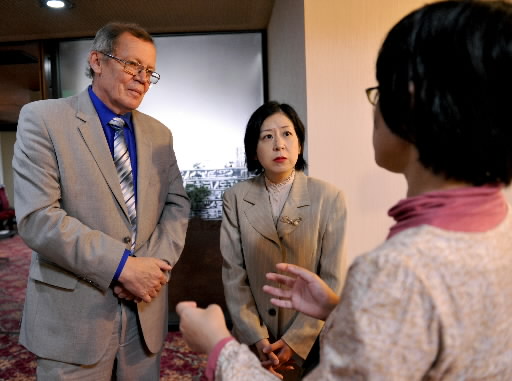Fukushima and Hiroshima: Lessons from Chernobyl, Part 6 [1]
Oct. 31, 2011
Article 1: Food contamination
by Yoko Yamamoto and Yo Kono, Staff Writers
Twenty-five years have passed since the accident at the Chernobyl nuclear power plant. The Chugoku Shimbun explores how the lessons learned by Eastern European nations in connection with Chernobyl can be used in responding to the nuclear disaster in Fukushima.
Japanese standards too lenient
“I was amazed at how lenient the Japanese standards are. It’s beyond my comprehension,” said Uladzimir Bebenka, deputy-director of the Institute of Radiating Safety “Belrad.” Mr. Bebenka traveled from Belarus to give a lecture in Tokyo in mid-October. He was pointing out how the provisional standards for food set by the Japanese government accept comparatively high amounts of radioactive substances. He has been conducting research on food contamination in the largest area that has suffered contamination of the food supply since the Chernobyl nuclear power plant accident in 1986.
In Japan, for example, the standard limit for cesium in drinking water has been set at 200 becquerels per liter. This is 20 times the amount set by the current standards in Belarus.
The limit for beef in both countries is the same, but the limit for vegetables in Japan is 6.8 times as high, bread is 12.5 times as high, and so on. “I can understand if these values were applied right after the accident,” Mr. Bebenka said. “But even now that the gravity of the situation is known, these standards continue to be used. It only worsens the public’s mistrust and heightens confusion.”
Standards toughened in stages
According to the International Commission on Radiological Protection (ICRP) and other sources, the former Soviet Union set a limit for cesium in food, including in drinking water and milk, at 370 becquerels and beef at 3,700 becquerels per kilogram. These standards in the former Soviet Union were more lenient than the provisional limits set for food by the Japanese government on March 17 in the wake of the accident at the Fukushima No. 1 (Daiichi) nuclear power plant. It is said that the limits in the former Soviet Union were based on the calculation that “the combined level for external and internal exposure to radiation must be within 100 millisieverts per year.”
But this level of 100 millisieverts was made stricter in stages. For instance, in 1987, the year following the accident, the annual dose limit was cut in half, to 50 millisieverts. In further stages, the limit was tightened to 30 millisieverts per year and then 5 millisieverts. Belarus, which became independent in 1991 after the collapse of the Soviet Union, lowered the limit to as low as 1 millisievert per year by 1998. This strict limit was made, in particular, with an eye on toughening the standards for the kinds of food consumed by children.
Still, despite all these efforts, the people we spoke to in Belarus continue to feel dread when it comes to their health, even a quarter-century since the accident occurred. And indeed, when their bodies are tested using a whole body counter, cesium has been detected.
In July, Japan’s Food Safety Commission presented the view that “radiation exposure over a person’s lifetime should be limited to a maximum accumulation of 100 millisieverts.” However, the breakdown in levels involving external exposure and internal exposure has not been proposed. How the new standards for radiation exposure will be set is still anybody’s guess.
Call for solidarity
In Belarus, private organizations, including the “Belrad” institute, supported by western nations and other entities, have continued to shine a spotlight on the problem of contaminated food. Tetsuji Imanaka, a research associate at the Kyoto University Research Reactor Institute and a second-generation A-bomb survivor born in Hiroshima, has contributed to his institute’s efforts by analyzing data and through other activities.
Since its founding in 1990, the institute has established “radiology training centers” at schools located in areas contaminated with radiation. It has measured the contamination of agricultural products and provided support to such work as research on contamination being conducted in these areas by local students who are supervised by experts.
At the gathering to which Mr. Benbenka was invited, a number of troubling questions were raised in succession by the over 200 participants at the venue: “Are the Japanese standards all right?” “What should we do to protect our children from the harm caused by contaminated food?”
Mr. Bebenka urged the participants to “form citizens’ groups in each area and form networks among them. To continue living in our homelands, we must strengthen our solidarity.” He expressed conviction that the power of private citizens and organizations can overcome the difficulties.
(Originally published on October 27, 2011)








